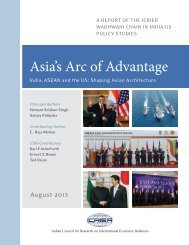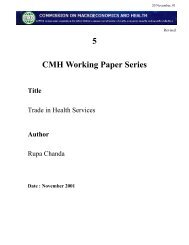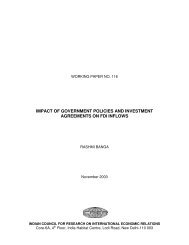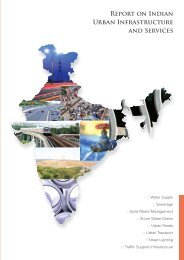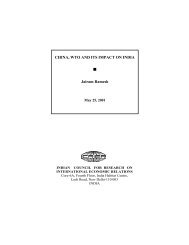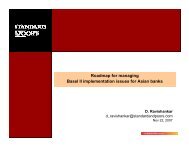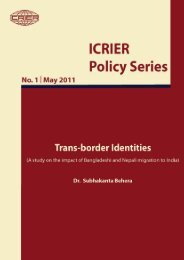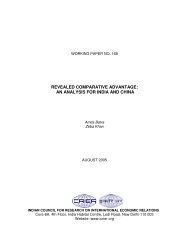Arpita Mukherjee Ramneet Goswami January 2009 - icrier
Arpita Mukherjee Ramneet Goswami January 2009 - icrier
Arpita Mukherjee Ramneet Goswami January 2009 - icrier
You also want an ePaper? Increase the reach of your titles
YUMPU automatically turns print PDFs into web optimized ePapers that Google loves.
and New Zealand, used the Build-Operate-Own-Transfer (BOOT) mode to attract foreign<br />
investment. 32<br />
Liberalization allowed alternative providers to enter the market to supply services such<br />
as metering, billing, maintenance, repair, installation, and upgrading activities for oil, gas and<br />
electricity services. Privatization and regulatory reforms made it possible for companies to<br />
switch quickly between fuels and bundle energy services in innovative ways. For instance, oil<br />
and gas companies can now own electric plants; and electric utilities can have stakes in gas<br />
pipelines. An increasing number of utility companies, oil companies and energy equipment<br />
manufacturers started building on their respective competencies to supply energy services on<br />
a more integrated basis. The companies are now competing to provide a full range of energy<br />
asset and energy facilities management services which benefit both customers and<br />
companies. Customers benefit since they are able to purchase a range of fuels and equipment<br />
combined with supporting services at a lower cost from a single supplier and this made the<br />
companies particularly successful with large industrial and commercial customers. The<br />
process of deregulation in network industries (telecommunications, electricity, gas,<br />
transportation, etc.) led to new types of regulations (independent regulators), pricing<br />
mechanisms and market structures. The regulators imposed Universal Service Obligations<br />
(USOs) 33 which forced energy utilities to supply service in a continuous manner, to meet the<br />
needs of all customers, and provide it at the minimum possible price.<br />
The growth of integrated service providers led to specialization. Some energy<br />
companies gravitated toward asset-based strategies focusing on energy manufacturing and<br />
energy delivery. Others focused on energy trading. The industry also witnessed mergers and<br />
acquisitions as companies tried to optimize their mix of goods and services. In the US, 22<br />
mergers, worth US$56 billion, were announced between 1997 and 1999. Similar trends were<br />
visible in the European energy companies. Cross-border mergers and acquisitions also<br />
increased. In the electricity sector alone these transactions increased from US$20 billion in<br />
1996 to US$38 billion in 1999. 34 Mergers and acquisitions and the growth of large players<br />
have raised concerns about anti-competitive practices.<br />
2.1.1 Coal<br />
The liberalization process in different sub-sectors is given below.<br />
The structure of the coal industry has undergone considerable changes – from being a<br />
state-owned monopoly catering to the domestic market to an internationally competitive<br />
sector. Till the 1970s, isolated national producers dominated the coal industry. The oil crises<br />
in 1973 and 1979 initiated a series of reforms leading to rapid development of the<br />
international coal market. Many countries in Latin America, Africa, Eastern Europe and<br />
Central Asia introduced reforms in mining services in order to attract private sector<br />
investment in exploration and production (E&P) activities. With the opening up of the sector<br />
for foreign competition, governments started reducing subsidies and multinational<br />
corporations such as Anglo American, BHP Billiton, CONSOL Energy Inc., RAG Group and<br />
Rio Tinto with specializations in key activities (such as mining) entered this sector, gradually<br />
replacing the local coal producers. For instance, in Russia until 1993, the majority of the coal<br />
industry was state-owned and private producers accounted for less than 10 per cent of total<br />
32<br />
BOOT is the same as BOT, except that instead of receiving a fee for operation, the private entity receives a net<br />
income from the asset.<br />
33<br />
To provide a legal obligation to serve all customers, including those that may not be commercially attractive.<br />
34<br />
Evans, P.C. (2002).<br />
13




